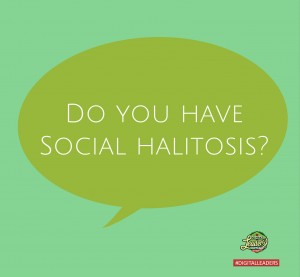Toxic behaviors: Social halitosis, flatulence, and dandruff
 After reading the 33 Strategies of War and the Art of Seduction, I now find time to read this book which has been in my plastic full of books for quite sometime now, Karl Albrecht’s “Social Intelligence: The New Science of Success.”
After reading the 33 Strategies of War and the Art of Seduction, I now find time to read this book which has been in my plastic full of books for quite sometime now, Karl Albrecht’s “Social Intelligence: The New Science of Success.”
I just finished chapter 1 and here I am blogging about it.
Social halitosis
According to Albrecht, social halitosis is the conversational equivalent of a bad breath where one exhibits inauthentic and inconsiderate behavior. This is much like your friend who is engaged in multi-level marketing and tends to be insensitive, inconsiderate, and keeps on gently harassing you every now and then to join their group. Unfortunately, because of our training to listen politely, most of us don’t know how to blew this people away.
I guess that is why salespersons in appliance or grocery stores who are demonstrating a product repetitively, much like a robotic mindless recitation of a scripted message, turns us off.
There is also your friend whom whenever you meet would only want to talk about themselves, their problem, or their travels the whole time. This they do wherever they go or whom they get to talk to. They want their concerns to be the center of discussion.
Social flatulence
There is also social flatulence. You know you are with a person that has this when they exhibit some form of behavior or reaction that only has one intent, to be noticed. They are usually inappropriate with what they say, incosiderate, crude, lack of respect, in short – a “social fart”.
Social dandruff
You know that a person has social dandruff when they selfishly impose their interest on others. This is like doing a hair, make-up, or perfume touch up even if your “beauty effects” are spreading to other people. Talking loud on the phone in a public train. People who yell in a public Internet cafe that tends to disturb other renters. Or simply blowing away people just because they have a different political or religious views in life.
Of course, this is not to mention that we have friends who are probably like the Dilbert comic characters whose self-esteem, limited self-insight, adolescent-like sense of humor affects their relationship with people and career growth.
One way or another, most of us had committed one or all of the above toxic behaviors. Albrecht’s book aims to teach improvement in one’s skills of interaction. The book covers five dimensions or categories of competence such as:
- Situational awareness – ability to read situation and interpret people’s behavior
- Presence – one’s bearing, patterns, appearance, voice, movement
- Authenticity – social radars that other people pick up
- Clarity – ability to explain, illuminate ideas, articulate views, propose actions that get others to cooperate
- Empathy – connected with another person for positive interaction and cooperation.
More sharing to come, good thing the book author is encouraging it.
Reflection:
Have you committed any toxic behavior lately? What are your plans to change it?